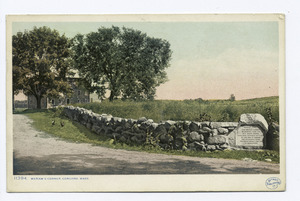Meriam's Corner facts for kids
Quick facts for kids Meriam's Corner |
|||||||
|---|---|---|---|---|---|---|---|
| Part of the battles of Lexington and Concord | |||||||
 An early 20th-century postcard of Meriam's Corner, looking northeast. In view is the Nathan Meriam House |
|||||||
|
|||||||
| Belligerents | |||||||
| Massachusetts Bay | |||||||
| Commanders and leaders | |||||||
| Casualties and losses | |||||||
| 0 | 2 | ||||||
Meriam's Corner is a very important historical spot from the American Revolutionary War. It is famous for being where the first real fight happened during the battles of Lexington and Concord in 1775.
You can find Meriam's Corner in Concord, Massachusetts. It's where two roads meet: Lexington Road and Old Bedford Road. The place is named after the Meriam family, who lived there a long time ago. The old Nathan Meriam House is still standing right there. Both the house and Meriam's Corner are now part of the Minute Man National Historical Park. In 1775, three Meriam family homes were at this corner.
On the afternoon of April 19, 1775, something big happened here. It was the first time the British soldiers, called "Redcoats," were attacked by the American colonists. The Redcoats were trying to get back to Boston after their morning march. Earlier that day, the first shots of the war had been fired at Lexington Battle Green.
Near Meriam's Corner, there's a stone marker. It shows where at least one of the two British soldiers killed during the fight is buried. Another stone marker, put up in 1885, explains that the British troops were attacked here as they retreated from the Old North Bridge.
British Soldiers Retreat from Concord
Lieutenant Colonel Francis Smith was in charge of the British soldiers. He was worried about his men's safety as they left Concord. He sent soldiers, called "flankers," to walk along a ridge. Their job was to protect the main group from the American colonists, who now numbered about a thousand.
This ridge ended near Meriam's Corner. At this spot, the main road crossed a small, narrow bridge over Elm Brook. To get across the bridge, the British soldiers had to bring their flankers back into the main group. They had to walk very close together, only three soldiers wide.
Meanwhile, many American militia groups were arriving from different directions. They gathered at Meriam's Corner. This gave them a clear advantage in numbers over the British. The British leaders were seeing what they had tried to avoid: American colonists gathering by the thousands whenever British soldiers left Boston.
As the last British soldiers crossed the small bridge, the soldiers at the back of their group turned around. They fired their guns at the American militia. The colonists had been firing from a distance, but now they were much closer. The colonists fired back, and this time their shots hit their targets. Two British soldiers were killed, and about six were wounded. No American colonists were hurt. After crossing the bridge, Colonel Smith sent his flankers out again to protect his troops.


